sjvalleyhunter
Silver Member
- May 5, 2014
- 3,716
- 2,172
- Detector(s) used
- Minelab E-Trac and Whites MXT
- Primary Interest:
- Metal Detecting
A few folks have recently asked me to post how I cover my pinpointer. I’ve been hesitant on doing so because I know that the naysayers will come out of the woodwork and will be quick to post comments about how they don’t think pinpointer covers are necessary or they will be happy to point out the flaws or drawbacks in using this type of cover. So, let me preface this post by saying this: This cover works very well for me, but it will not work for everyone. If you are the type of detectorist who wears down the tip of your pinpointer, then this cover will probably not benefit you. I’ve never understood how someone can wear down the plastic on a pinpointer. Personally, I use a pinpointer for what it is – a metal detector. I don’t jab and force it into the ground and dig around with it. After all, you wouldn’t put your foot on the back of your detector’s coil and try to push it into the ground like a shovel. If I need to move dirt, I use the tool that is designed for that, my Lesche.
Yes, there are a few drawbacks in using this covering method. For one, the built in “scraping blade” is made ineffective, but I’ve always thought that this was kind of gimmicky anyway. This cover also covers up the light on the pinpointer. During my day hunts I don’t dig holes so deep that the bottom of the hole is dark and I need a light to see, and for the few night hunts that I do, I carry an external light. Therefore, I don’t mind if the light is covered.
I realize that there are other covering methods that are used, including dipping the pinpointer in liquid plastic and the commercial covers that are available on eBay and elsewhere. Those work, I’m sure. But I don’t want to spend a lot of time or money to do something that I can do in ten minutes at home that will cost me just a few cents.
Ok, now that I got that out of the way, let me explain why and how I cover my pinpointer. I am very particular about keeping my equipment clean after a day’s use. I am a firm believer that equipment that is well maintained and kept clean lasts longer, works better, and has a higher resale value if it’s ever sold. For this reason I use a cover on my pinpointer. The method I use is very cheap but highly effective in keeping out dust and water. In fact, I would feel completely comfortable in fully submersing the pinpointer in water if needed without worrying about getting water in it.
Here is my three year old Garrett Pro Pointer. I get out and hunt at least once a week and have hundreds of hours of use with this pinpointer. Because of the covers, it looks absolutely brand new. The covers last a full battery life and I just replace them each time I replace the battery.
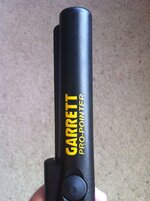
You only need two things: a good quality rubber glove and strong tape. That’s it. I am fortunate that I have access to surgical gloves from a local hospital. They are a tad bit thicker than those common tan colored rubber gloves. Any glove will work, but if you can get a hospital glove or something similar then all the better. The other item needed is tape. For years I used regular masking tape which works fine, but recently started using Gorilla tape simply because it’s stronger and lasts a little longer.
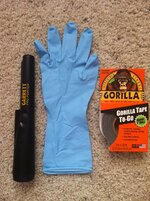
First, place the pinpointer into the glove and down the middle finger. I like to cut off the extra fingers, but they can be left on if you don’t mind the finished product being a little bulky. I then take one or two of the fingers that were cut off and slide them over the tip to give it a couple extra of layers of rubber. If the glove is long like this one, I will also cut off any excess around the wrist area.
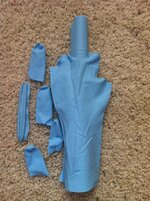
Using the tape, seal off each of the cut fingers and fold over the wrist area and seal it with the tape. Make sure that the finger holes are completely sealed.
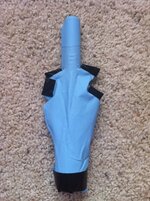
Now I put a few layers of tape over the tip to reinforce it a bit. I also feel for where the on/off button is and frame it off with tape so I know where it is. Once that is done, I start to wrap the whole thing in the tape, being careful not to wrap tape over the button. (It’s ok if you do, it’s just harder to feel for the button each time you use it.)
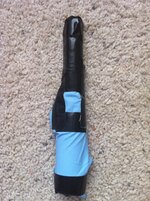
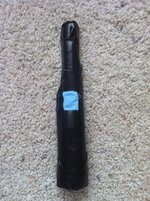
A lot of times I stop here and I’m done. However, with the many colors of duct tape that are available, I often will put on one more layer of tape. I personally like the camouflaged look, but beware – If you wrap you pinpointer in camouflaged tape and drop it somewhere in the field, good luck finding it! I know this from experience.
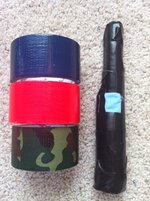
Today I will use the blue tape. I placed a small piece of red tape over the button and then wrapped the whole thing in one layer of blue duct tape. That’s it, all done.
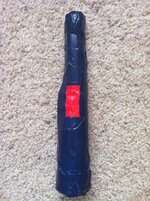
The layers of rubber and tape are thick enough to protect the pinpointer from dirt and the elements, but they by no means add any thickness that will affect the performance of the device. If it’s submersed in water, the water will have to work its way through many layers of tape and rubber, which is darn near impossible. After an outing, I just wash the whole thing off under a faucet to clean it. Like I said, the cover will last longer that the life of a battery, and when the battery dies I just cut off the cover and replace it with a new one. I have used this method on a number of different brands and styles of pinpointers over the years and have never had one fail. The tip will get frayed, but I’ve never had one wear through. If it starts to get frayed, just put on a couple layers of tape and you are good to go.
I hope this method will help any of you who are looking for a simple, cheap and effective way to cover your pinpointer. If you have any questions or any ideas on how to improve this, please let me know.
Yes, there are a few drawbacks in using this covering method. For one, the built in “scraping blade” is made ineffective, but I’ve always thought that this was kind of gimmicky anyway. This cover also covers up the light on the pinpointer. During my day hunts I don’t dig holes so deep that the bottom of the hole is dark and I need a light to see, and for the few night hunts that I do, I carry an external light. Therefore, I don’t mind if the light is covered.
I realize that there are other covering methods that are used, including dipping the pinpointer in liquid plastic and the commercial covers that are available on eBay and elsewhere. Those work, I’m sure. But I don’t want to spend a lot of time or money to do something that I can do in ten minutes at home that will cost me just a few cents.
Ok, now that I got that out of the way, let me explain why and how I cover my pinpointer. I am very particular about keeping my equipment clean after a day’s use. I am a firm believer that equipment that is well maintained and kept clean lasts longer, works better, and has a higher resale value if it’s ever sold. For this reason I use a cover on my pinpointer. The method I use is very cheap but highly effective in keeping out dust and water. In fact, I would feel completely comfortable in fully submersing the pinpointer in water if needed without worrying about getting water in it.
Here is my three year old Garrett Pro Pointer. I get out and hunt at least once a week and have hundreds of hours of use with this pinpointer. Because of the covers, it looks absolutely brand new. The covers last a full battery life and I just replace them each time I replace the battery.

You only need two things: a good quality rubber glove and strong tape. That’s it. I am fortunate that I have access to surgical gloves from a local hospital. They are a tad bit thicker than those common tan colored rubber gloves. Any glove will work, but if you can get a hospital glove or something similar then all the better. The other item needed is tape. For years I used regular masking tape which works fine, but recently started using Gorilla tape simply because it’s stronger and lasts a little longer.

First, place the pinpointer into the glove and down the middle finger. I like to cut off the extra fingers, but they can be left on if you don’t mind the finished product being a little bulky. I then take one or two of the fingers that were cut off and slide them over the tip to give it a couple extra of layers of rubber. If the glove is long like this one, I will also cut off any excess around the wrist area.

Using the tape, seal off each of the cut fingers and fold over the wrist area and seal it with the tape. Make sure that the finger holes are completely sealed.

Now I put a few layers of tape over the tip to reinforce it a bit. I also feel for where the on/off button is and frame it off with tape so I know where it is. Once that is done, I start to wrap the whole thing in the tape, being careful not to wrap tape over the button. (It’s ok if you do, it’s just harder to feel for the button each time you use it.)


A lot of times I stop here and I’m done. However, with the many colors of duct tape that are available, I often will put on one more layer of tape. I personally like the camouflaged look, but beware – If you wrap you pinpointer in camouflaged tape and drop it somewhere in the field, good luck finding it! I know this from experience.

Today I will use the blue tape. I placed a small piece of red tape over the button and then wrapped the whole thing in one layer of blue duct tape. That’s it, all done.

The layers of rubber and tape are thick enough to protect the pinpointer from dirt and the elements, but they by no means add any thickness that will affect the performance of the device. If it’s submersed in water, the water will have to work its way through many layers of tape and rubber, which is darn near impossible. After an outing, I just wash the whole thing off under a faucet to clean it. Like I said, the cover will last longer that the life of a battery, and when the battery dies I just cut off the cover and replace it with a new one. I have used this method on a number of different brands and styles of pinpointers over the years and have never had one fail. The tip will get frayed, but I’ve never had one wear through. If it starts to get frayed, just put on a couple layers of tape and you are good to go.
I hope this method will help any of you who are looking for a simple, cheap and effective way to cover your pinpointer. If you have any questions or any ideas on how to improve this, please let me know.


